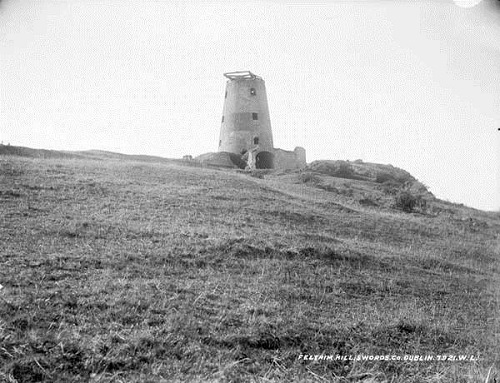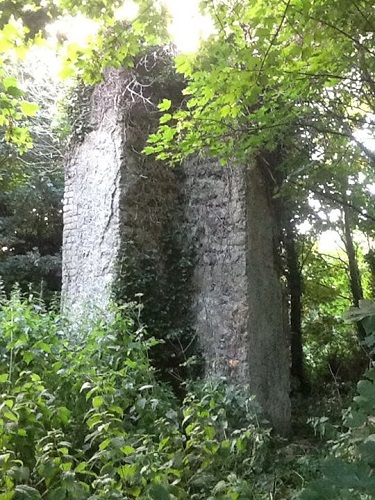The Fagans of Feltrim
(selected excerpts regarding the 'Fagans of Feltrim')
Feltrim
From D'Alton1: "On the grange of Portmarnock, at left of the line, is an ancient fort about thirty-six feet in diameter ; and hereabouts, a view may be caught of the handsome chapel of Kinsaly, and the historic and picturesquely situated hill of FELTRIM, for centuries the residence of the Fagan family, now crowned with a large windmill, that forms a very conspicuous object from every direction. In the reign of Elizabeth, when the unfortunate Earl of Desmond was a prisoner of state in Dublin Castle, his health requiring country air, the custody of his person was committed to Christopher Fagan of Feltrim, who nobly informed the government, that as his guest, the Earl was most welcome to entertainment at his house, but that he should never become his gaoler. Desmond, in such liberal guardianship, was permitted to walk abroad on his parol, a privilege which he abused, and effected his escape into Munster, where, entering soon after into open rebellion, he was treacherously murdered by some of his own followers. The family residence here, is also said to have received the unfortunate James the Second, in his flight from the Boyne, and the chamber was at no very remote period confidently shown, where he passed the weary hours of one wretched night."
From the Malahide Historical Society2: "An archaeological dig took place on Feltrim Hill in 1947 and upwards of 500 items of interest were found. These included Roman coins and a tinned bronze mount dating to the 4th. Century A.D. Feltrim Castle was originally a ‘Ten Pound Castle’, built in 1429. The Fagan family has always been associated with Feltrim and in 1574 Sir Christopher Fagan allowed Gerald, Earl of Desmond, to escape even though he had been committed to him as a prisoner on parole.
In 1690, fleeing from the Battle of the Boyne, King James stayed for some time with Richard Fagan of Feltrim. From the 1700’s onwards the Fagan family suffered an eclipse and Feltrim Castle was demolished by the mid-eighteenth century. In the environs of the castle, Fagan’s Well still stands in a good state of preservation Also in the neighbourhood are to be found the Well of St. Werburgh, Crow’s Castle, The Hanging Tree, where executions took place in Penal Times and the remains of Malahide’s oldest house, Drynam House, built in the reign of Charles 1st.
Superstitions abound at Feltrim. Stories are still told to-day of the grey ghostly horse, the big black dog with blazing eyes and the old hag, with her bundle of faggots always gliding in the direction of the Holy Well.
Feltrim Hill is best remembered, to-day, for its wind mill or lack of it. The tower windmill was built in 1668 of best quality Dutch bricks and by craftsmen from Holland. It started out as a woolen mill and became a corn mill c.1700. Around 1800, it was used as a semaphore mill and transmitted messages from Dublin to the next hill tower, all the way to Belfast. In 1839 the sails of the windmill were blown off and up till Saturday night October 23rd. 1973, Feltrim Mill stood on the hill as an affectionate landmark for all who passed by. Sadly, on that fateful Saturday night it was demolished and the chains which helped to pull it down still are trapped underneath the bricks to-day."
Feltrim Windmill

From Independant.ie3: "The story of the Feltrim windmill is one of the most dramatic in terms of Fingal’s heritage. Had it stood today, it would have matched Skerries for one of the most beautiful sights in the region. All that remains of the structure is part of the interior but even that is striking in its design. It should be noted that the structure is fenced off and on private property. The Feltrim windmill was built in the late 1600s from red Dutch bricks (still there) and by Dutch workers. It was used as a woolen mill to start and then a corn mill for up to 100 years, ending in the great storm of 1839 when the giant sails were blown off. It still stood magnificently for many decades later until 1973 when it was demolished on a Saturday night, ending centuries of dominance of the Feltrim skyline."
Remains of Castle Fagan (or the Fagan Manor House) Feltrim

From the Feltrim & Kinsealy History Community Organization Facebook page4: "The remains of Fagan's Castle on Feltrim Hill. Built in 1427 by the Fagan family, a once powerful Catholic family who's power waned significantly after the Battle of the Boyne. It has recently emerged that Princess Charlene of Monaco is a direct descendant of the Fagans."
In issue 26, on page 10 of Irish Lives Remembered5 there is a similar picture which may or may-not be the same structure. The picture states "After 1560 Richard Fagan built an imposing manor house at feltrim. His descendants were known as the Fagans of Feltrim. in 2014 the Fagan's mansion lies in ruins, overgrown by woodland."
Technogypsie...
There's an interesting article at Technogypsie on Feltrim as well! It tells of Feltrim Hill Quarry and Well, Feltrim Castle, Fagan's Well and the old Hag, and The Windmill.
References:
1 D'Alton, John. The History of Drogheda: With Its Environs, and an Introductory Memoir of the Dublin and Drogheda Railway.
2 "Illustrated Guide to Historical Malahide - Part II." Archive.is. Malahide Historical Society, n.d. Web. 31 Aug. 2015.
3 Hubert Murphy. "Feltrim Hill - a Place of Peace, Intrigue and Great Tradition." Independent.ie. Independent House, Dublin, 07 Jan. 2005. Web. 31 Aug. 2015.
4 Feltrim & Kinsealy History Community Organization Facebook page
5 Fitzsimons, Fiona. "The Irish Family History of Princess Charlene of Monaco." Irish Lives Remembered Genealogy Magazine. November/December 2014. Irish Lives Remembered Ltd., Nov.-Dec. 2014. Web. 01 Sept. 2015.
